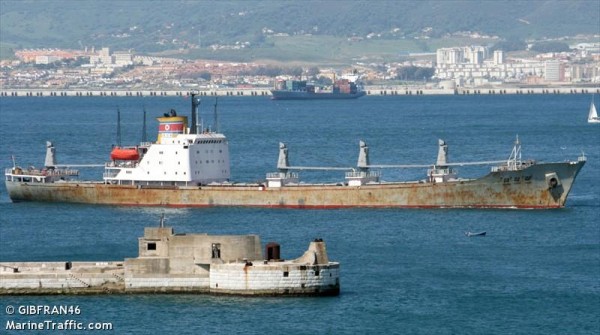
The North Korean freighter MV Chong Chon Gang (Photo: marinetraffic.com)
Sometimes you look at it, and it seems a fairly straight-forward, if somewhat bizarre, story. Then again, it bears a hint of mystery. A North Korean dry-cargo merchant vessel, MV Chong Chon Gang, traveling from Cuba to the Panama Canal, was boarded by Panamanian military personnel on suspicion that it was carrying contraband narcotics. The unarmed crew unexpectedly fought back with sticks and destroyed the ship’s cargo-handling equipment while the captain attempted suicide. (Evidently, he expected to be in trouble when he got home.) After successfully seizing the ship, the Panamanians found radar equipment, missile systems, and aircraft components in shipping containers hidden among 10,000 tons (240,000 sacks) of Cuban brown sugar. Arms shipments to North Korea are barred by U.N. Security Council Resolution 1718 (2006).
By odd coincidence, a U.N. Panel of Experts had just released a report in June on North Korean efforts to circumvent sanctions, including those regarding the trade in prohibited military goods. Panama, reluctant to take the lead on a sensitive issue of international security, called on the U.N. to make a judgment as to whether the shipment violated the sanctions. In the meantime, setting aside the objections of Cuba and North Korea, Panama filed criminal charges against the entire crew of the Chong Chon Gang. Crew members are refusing to answer questions.
Cuba protested that it was not delivering arms to North Korea. The arms belonged to Cuba and dated from the 1950s (actually, the early 1970s in the case of the MiG-21Bis, but still pretty old). They were being sent to North Korea, the Cubans said, for refurbishment and upgrading and were then to be returned to Cuba. As an explanation of what was happening, this is plausible. As an excuse, it serves less well. The provision of maintenance services to or from North Korea was banned by the same resolution.
Jeffrey Lewis, at the Monterey Institute for International Studies, points out that the North Korean refurbishment story actually clears up some past mysteries regarding Cuba. Analysts had been wondering since 2006 who had upgraded some Cuban mobile missile launchers, for which Soviet-era surface-to-air missiles had been mounted on archaic Soviet-era tank chassis. It could be that North Korea has been maintaining and upgrading the island’s military equipment for some time, applying its comparative advantage in out-of-date, Soviet-style technology. Lewis, among others, also suspects that the sugar was the payment for the service. A barter arrangement can facilitate trade between two cash-strapped nations, and it does not require the participation of international banks that could report the transaction to the UN Sanctions Committee.
One question that arises, though, is why the North Koreans were caught so easily when in the past they have been fairly successful at smuggling weapons and other contraband. For example, at times they have made their shipments less conspicuous by sending sealed containers on unsuspecting foreign freighters. On other occasions their ships have made intermediate stops at unrelated ports to throw off suspicion. Shipments have been intercepted before, of course, but as Elias Grol points out (citing SIPRI’s Hugh Griffiths), this particular operation seems sloppy and amateurish. They traveled directly from Cuba to North Korea; they used a ship that had been caught carrying contraband before; the ship had a large, conspicuous North Korean flag painted on its funnel; they sailed through Panama, where the president prided himself on intercepting illicit narcotics shipments. Given the outdated, low-quality, low-value contraband that the vessel carried, one is almost tempted to believe that it was a decoy intended to draw attention to itself. Yet, for all we know, the North Koreans may have had plenty of sloppy, amateurish missions in the past that just happened to be lucky enough not to get caught. They always seem brilliant when they succeed.
There are questions for Cuba, as well. Raúl Castro has been making efforts to improve relations with the United States. Why take the risk of engaging in an illicit deal with North Korea at a time like this? Well, there are considerations that could be weighed against the risks. The weapons, while out of date, are the sort of thing that the Cuban military still uses and are probably in dire need of upgrading. Also, North Korea’s experience with Soviet equipment and willingness to take payment in sugar give it clear advantages over other service providers. Finally, if this arrangement has been going on undetected for years, as suggested by Cuba’s upgraded mobile missile launchers, then this case may have been viewed as a routine decision to be made by mid-level bureaucrats, rather than a risky operation to be decided at the highest levels.